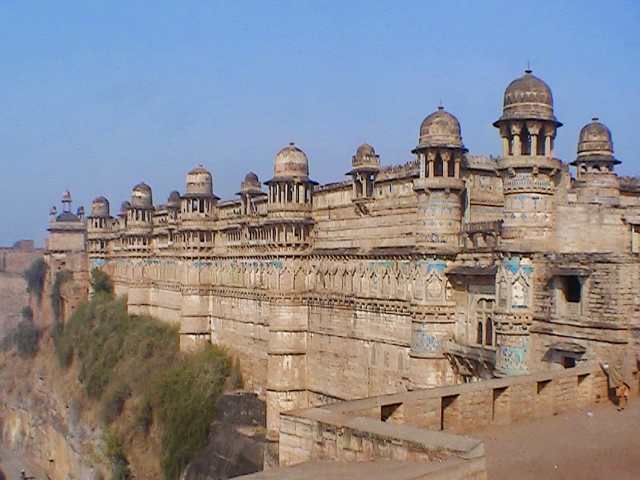Behold the architectural splendor that is the Gwalior Fort, a masterpiece that stands as a testament to the rich heritage of Indian architecture. This formidable fort, nestled in the heart of India, is a captivating blend of historical significance and artistic brilliance.
Constructed on a majestic hilltop, Gwalior Fort boasts a commanding presence that has witnessed centuries of Indian history. The intricate details and grandeur of its design showcase the skilled craftsmanship and architectural prowess of the builders who contributed to its creation.
Gwalior Fort is not merely a physical structure; it is a living chronicle of India’s cultural tapestry. Its walls echo with tales of valor, dynasties, and the ebb and flow of time. As visitors explore its labyrinthine passages and awe-inspiring structures, they embark on a journey through the annals of Indian history.
The fort’s architecture seamlessly fuses various styles, reflecting the diverse influences that have shaped the region over the ages. From imposing gates to ornate palaces, every corner of Gwalior Fort exudes an aura of regality and artistic brilliance.
As a symbol of India’s architectural heritage, Gwalior Fort invites visitors to marvel at its grandeur, immerse themselves in its history, and appreciate the enduring legacy of Indian craftsmanship. It stands not just as a fortification of stone and mortar but as a living testament to the artistic ingenuity that has shaped the landscapes of India.
Gwalior Fort in India
Nestled in the historic city of Gwalior, Madhya Pradesh, India, the Gwalior Fort stands as a sublime masterpiece of ancient Indian architectural art. Spanning over an expansive three square kilometers, this well-preserved historic complex is enveloped by formidable sandstone walls, creating a captivating ambiance.
Emperor Babar, the great Mughal ruler of the 15th century, once aptly described Gwalior Fort as “The pearl in the necklace of the forts of Hind.” Perched on a hilltop, soaring 100 meters above the plains, the fort offers a commanding view of the city below. Gwalior, steeped in history, boasts numerous grand structures, with the Gwalior Fort standing out as the most renowned among them. This fortress, a testament to the resilience of Indian castles, has witnessed the rule of numerous monarchs over the ages.
Gwalior Fort: An Ancient Marvel of Indian Architectural Excellence
Dating back to the fifth century AD, the Gwalior Fort’s architectural legacy reflects the influences of the Guptas, the Hunas, the Pratiharas, the Kachhwahas, the Tomars, the Pathans, the Mughals, the Marathas, and the English. Notable monuments within the fort include Man Mandir, Teli-Ka-Mandir, Sas Bhau Temple, Badal Mahal, Alamgiri gate, Ganesa gate, Chaturbhuj gate, Rock-cut Jain colossi, Urwai gate, and more.
Gopachal, the hill on which Gwalior Fort stands, is encircled by a two-mile-long wall, ranging in width from one kilometer to 200 meters. Man Singh Palace, constructed in the 15th century, holds historical significance, including the imprisonment and subsequent murder of Mughal emperor Aurangzeb’s brother, Murad. The palace, often referred to as the “painted palace” or “Chit Mandir,” showcases intricate designs and vibrant colors on its walls.
The Teli-Ka-Mandir, also known as the “Oilman’s Temple,” stands as one of the oldest monuments within the fort, dating back to the 8th century. Another notable structure is Garuda, dedicated to Pratihara Vishnu, and the twin Vaishnava temple called Sas Bahu, constructed during the Kachchapghatta reign, boasting unique architectural features.
Gwalior Fort’s enduring strength is further exemplified by its water reservoirs, strategically designed to meet the needs of a 15,000-strong garrison, underscoring the fort’s strategic importance in securing the region.
Despite enduring battles and peaceful periods, the mighty Gwalior Fort has stood the test of time, undergoing periodic restorations by rulers, ensuring its legacy continues to be cherished as an architectural marvel and a testament to India’s rich historical tapestry.

